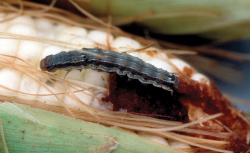
Features
Production
Research
Insecticide combo can deliver knockout punch
can deliver knockout punch
May 15, 2008 By Fruit & Vegetable
A cocktail of insecticides
containing a plant protein and a common insecticide may be more lethal
to crop pests than either ingredient used alone, according to
biologists.
 |
| Researchers found that a concentration of Bt at five parts per billion combined with Mir1-CP at a concentration of 60 parts per billion killed 61 per cent of corn earworms, more than 10 times the amount killed by either by itself. Photo by Jack Dykinga, USDA-ARS |
A cocktail of insecticides containing a plant protein and a common insecticide may be more lethal to crop pests than either ingredient used alone, according to biologists.
The combination’s one-two punch also inhibits the insects’ growth rate and reduces their chance of developing resistance, research suggests.
“We found a synergistic effect, where the two insecticides together decreased the growth rate of caterpillars more than either one did alone,” says Dawn Luthe, professor of plant stress biology at Penn State University. “The insect mortality rate was also much greater than the sum of mortality rates when only one insecticide was used.”
One of those insecticides, Bt, is commonly used around the world. When insects feed on plants genetically modified to produce Bt, the toxin binds to chemical receptors lining the insects’ midgut. This disrupts the receptor’s function, eventually killing the insects. But researchers say some insects always survive the ordeal and over time subsequent populations could develop resistance to the toxin.
Luthe and her colleagues Srinidhi Mohan and Peter W.K. Ma, post-doctoral student and professor at Mississippi State University, and W. Paul Williams, research geneticist at the U.S. Department of Agriculture, studied a unique plant-based insecticide known as Mir1-CP.
Their goal is to see if Mir1-CP, when used in tandem with other biological pesticides, such as the Bt toxin, can prevent pests from developing resistance and make the toxin more effective.
“This protein, which we developed from certain strains of corn from Antigua, breaks down other proteins and peptides in the insects’ gut,” explains Luthe, whose findings appear in a recent issue of PLoS ONE.
Unlike Bt, Mir1-CP breaks down proteins in a protective membrane covering the midgut. This membrane acts as a barrier that protects the caterpillar from toxins in the diet, and cycles nutrients to the midgut.
“It is the caterpillar’s first line of defence against toxins and chemicals in its diet,” says Luthe.
The researchers fed insects a sublethal dose of the two insecticides to test the
effectiveness of both insecticides on the pests.
They found that when used alone, a concentration of Bt at five parts per billion killed four per cent of all corn earworms and five per cent of tobacco budworms. Mir1-CP, when used at a concentration of 60 parts per billion, killed eight per cent of the corn earworms and three per cent of the tobacco budworms.
But when researchers added the two insecticides together, the mixture killed 61 per cent of corn earworms and 57 per cent of tobacco budworms, which is more than 10 times the amount killed by either by itself. Researchers saw similar results against the fall armyworm and the southwest corn borer, when the insecticides were used at slightly different strengths.
In addition to a high mortality rate among the insects, the study indicates a significant decrease in the growth rate of the survivors.
“We think that Mir1-CP is making holes in the membrane, which in turn is making it easier for the Bt toxins to reach the insects’ midgut,” explains Luthe, whose work is funded by the National Science Foundation.
The Penn State researcher says the findings have important implications for agriculture because each year insects cause major losses to farmers. Nearly 20 per cent of major crops worldwide are lost to insects.
Genetically modified crops that produce the Bt toxin have managed to check the insects to some extent but Luthe says insects may be winning the fight.
“Researchers in the Mississippi delta have found resistance to Bt among some insect populations in the region,” Luthe notes. “There is a chance that sometime in the future Bt will not be as effective against pests as it is now.”
The Penn State researcher suggests strains of corn that naturally produce Mir1-CP could be cross-bred with other strains of corn that produce Bt to develop new varieties that are more effective against pests.
“If you have two mechanisms of attack, it will take much longer for an insect population to develop resistance to both modes of attack, and help slow the development of resistance,” Luthe adds.
Print this page